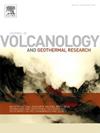Heat from dyke intrusions released by boiling of warm groundwater and steaming into the atmosphere during the 1975–1984 eruptive and intrusive activity at Krafla, Iceland
IF 2.3
3区 地球科学
Q2 GEOSCIENCES, MULTIDISCIPLINARY
Journal of Volcanology and Geothermal Research
Pub Date : 2025-06-10
DOI:10.1016/j.jvolgeores.2025.108396
引用次数: 0
Abstract
The Krafla volcano-tectonic episode in NE-Iceland in 1975–1984 was associated with approximately 10 m widening of the plate boundary within the Krafla caldera, where a high-temperature geothermal system is located. A composite dyke was formed, with an estimated volume 0.15–0.31 km3 within the geothermal reservoir, releasing thermal energy of 0.5–1.0 × 1018 J. An empirical relation between the area of steam clouds in air photos and their heat output was used to assess heat loss to the atmosphere by steaming during the Krafla fires. The applicability of this method for Krafla was tested in 2024 at selected locations where steam flow could be measured directly. Analyses of vertical air photos obtained several times in 1976–1985, notably during and after the eruptive events, show that steaming was mainly prevalent in the vicinity of the eruptive fissures. The heat loss to the atmosphere within the geothermal area was ∼0.9 MW/m during eruptions, declining to a more long-term value (∼0.05 MW/m) in 50–100 days. This enhanced steaming after the dyke injection/ eruption is considered to be caused by the interaction of the groundwater/shallow geothermal fluid with the uppermost 110–400 m of the dyke and appears to account for about one-third of the total heat lost in this way to the atmosphere. The remaining two-thirds were lost gradually throughout the rifting episode. The heat lost to the atmosphere (∼5–10 % of the total energy) was an order of magnitude smaller than the 90–95 % of the thermal energy added to the geothermal reservoir by the dyke.
1975-1984年冰岛克拉夫拉火山爆发和侵入活动期间,温暖的地下水沸腾并蒸汽进入大气,从而释放出堤坝侵入的热量
1975-1984年冰岛东北部Krafla火山构造事件与Krafla火山口内板块边界扩大约10 m有关,该火山口位于高温地热系统中。利用空气照片中蒸汽云的面积与其热量输出之间的经验关系,估算了克拉夫拉火灾期间蒸汽对大气的热损失,形成了一个复合岩脉,估计体积为0.15 ~ 0.31 km3,释放热能0.5 ~ 1.0 × 1018 j。2024年,在可直接测量蒸汽流量的选定地点测试了该方法对Krafla的适用性。对1976-1985年间多次获得的垂直航空照片进行分析,特别是在喷发期间和之后,表明蒸汽主要存在于喷发裂缝附近。在火山喷发期间,地热区大气的热量损失为~ 0.9 MW/m,在50-100天内下降到更长期的值(~ 0.05 MW/m)。在堤坝注入/喷发后,这种增强的蒸汽被认为是由地下水/浅层地热流体与堤坝最上层110-400米的相互作用引起的,并且似乎占以这种方式向大气损失的总热量的三分之一。剩下的三分之二在裂谷时期逐渐消失。损失到大气中的热量(占总能量的~ 5 - 10%)比大坝增加到地热储层的90 - 95%的热能要小一个数量级。
本文章由计算机程序翻译,如有差异,请以英文原文为准。
求助全文
约1分钟内获得全文
求助全文
来源期刊
CiteScore
5.90
自引率
13.80%
发文量
183
审稿时长
19.7 weeks
期刊介绍:
An international research journal with focus on volcanic and geothermal processes and their impact on the environment and society.
Submission of papers covering the following aspects of volcanology and geothermal research are encouraged:
(1) Geological aspects of volcanic systems: volcano stratigraphy, structure and tectonic influence; eruptive history; evolution of volcanic landforms; eruption style and progress; dispersal patterns of lava and ash; analysis of real-time eruption observations.
(2) Geochemical and petrological aspects of volcanic rocks: magma genesis and evolution; crystallization; volatile compositions, solubility, and degassing; volcanic petrography and textural analysis.
(3) Hydrology, geochemistry and measurement of volcanic and hydrothermal fluids: volcanic gas emissions; fumaroles and springs; crater lakes; hydrothermal mineralization.
(4) Geophysical aspects of volcanic systems: physical properties of volcanic rocks and magmas; heat flow studies; volcano seismology, geodesy and remote sensing.
(5) Computational modeling and experimental simulation of magmatic and hydrothermal processes: eruption dynamics; magma transport and storage; plume dynamics and ash dispersal; lava flow dynamics; hydrothermal fluid flow; thermodynamics of aqueous fluids and melts.
(6) Volcano hazard and risk research: hazard zonation methodology, development of forecasting tools; assessment techniques for vulnerability and impact.

 求助内容:
求助内容: 应助结果提醒方式:
应助结果提醒方式:


